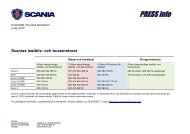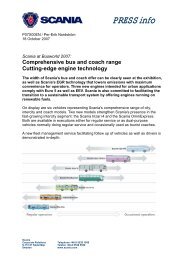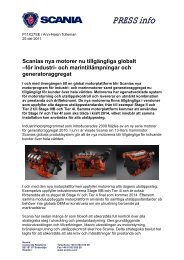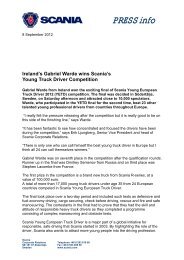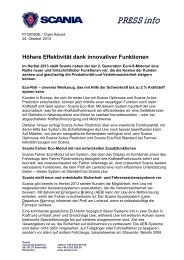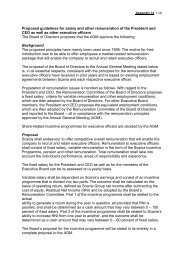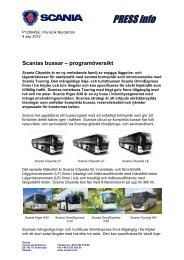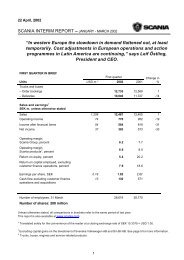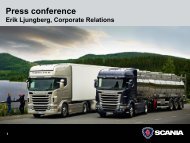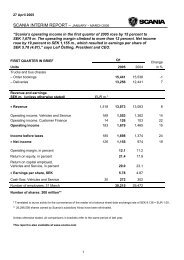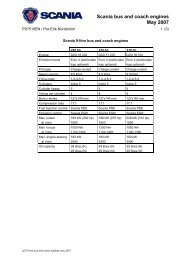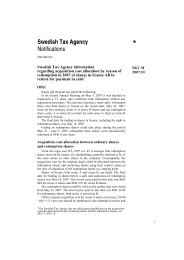Scania annual report 2004
Scania annual report 2004
Scania annual report 2004
Create successful ePaper yourself
Turn your PDF publications into a flip-book with our unique Google optimized e-Paper software.
Accounting principles<br />
The Annual Report of the <strong>Scania</strong> Group has<br />
cial <strong>report</strong>s resulting from these new and amended<br />
evaluated at the present value of expected<br />
Acquisitions of companies are <strong>report</strong>ed<br />
been prepared in compliance with the Annual<br />
recommendations are described below.<br />
disbursements, taking into account inflation,<br />
according to the purchase method of accounting.<br />
Accounts Act, the current recommendations of<br />
the Swedish Financial Accounting Standards<br />
Council and the statements of its Emerging<br />
RR 29 Employee Benefits<br />
Through the implementation of RR 29, defined<br />
expected future pay increases and using a discount<br />
interest rate equivalent to the interest rate<br />
on top-rated corporate or government bonds<br />
This means that the assets and liabilities in the<br />
acquired company are accounted for at acquisition<br />
values assigned by the purchaser according<br />
Issues Task Force. The recommendations of the<br />
benefit plans in all of the Group’s subsidiaries are<br />
with a remaining maturity corresponding to the<br />
to an acquisition analysis. If the acquisition value<br />
Council are based on the international accounting<br />
being <strong>report</strong>ed according to common principles.<br />
obligations in question. For plans that are fun-<br />
of the shares exceeds the value of the company’s<br />
principles adopted by the International<br />
Until the end of 2003, such plans had been<br />
ded, the fair value of the plan assets is subtrac-<br />
net assets according to the acquisition analysis,<br />
Accounting Standards Board.<br />
<strong>report</strong>ed according to each country’s local<br />
ted from the estimated present value<br />
the difference is <strong>report</strong>ed as goodwill on consoli-<br />
New accounting recommendations<br />
in <strong>2004</strong><br />
Beginning in <strong>2004</strong>, <strong>Scania</strong> is applying the<br />
regulations.<br />
The difference that arose due to the restatement<br />
of liabilities as per 1 January <strong>2004</strong> was<br />
<strong>report</strong>ed as a reduction in the provision for defined<br />
of the obligation. Actuarial gains and losses on<br />
obligations and plan assets are credited or charged<br />
directly to earnings when they arise.<br />
In the case of some plans in the Group that<br />
dation. Only earnings arising after the date of<br />
acquisition are included in the shareholders’<br />
equity of the Group. Divested companies are<br />
included in the consolidated financial statements<br />
Swedish Financial Accounting Standards<br />
benefit plans and an equivalent increase in<br />
are classified as defined benefit and which are<br />
until and including the divestment date.<br />
Council’s Recommendation RR 29 Employee<br />
shareholders’ equity.<br />
multi-employer plans, sufficient information can-<br />
Minority interests in net income and share-<br />
Benefits as well as the Emerging Issues Task<br />
Within the <strong>Scania</strong> Group, there are a number<br />
not be obtained to calculate <strong>Scania</strong>’s share of the<br />
holders’ equity are <strong>report</strong>ed separately.<br />
Force’s Statement URA 43 Reporting of Special<br />
Payroll Tax and Pension Fund Profit Tax. Certain<br />
changes in existing regulations occurred, which<br />
of both defined contribution and defined benefit<br />
pension and similar plans, some of which have<br />
assets that are managed by special foundations,<br />
plans. For this reason, these plans are <strong>report</strong>ed<br />
as defined contribution, in accordance with point<br />
30 of RR 29. This applies to the portion of the<br />
Associated companies<br />
“Associated companies” refers to companies in<br />
shall be applied beginning in <strong>2004</strong>. These changes<br />
funds or the equivalent. The plans are financed by<br />
Swedish ITP occupational pension plan that is<br />
which <strong>Scania</strong> has a long-term ownership interest<br />
occurred as a consequence of the efforts to<br />
payments from Group companies and to some<br />
administered via the retirement insurance com-<br />
and possesses a significant influence. Associated<br />
harmonise Swedish accounting rules and the<br />
extent by employees.<br />
pany Alecta as well as the Dutch Pensioenfonds<br />
companies are accounted for using the equity<br />
international accounting standards adopted by<br />
Plans in which <strong>Scania</strong> only pays fixed contri-<br />
Metaal en Techniek administered via MN Services<br />
method. This means that in the consolidated<br />
the International Accounting Standards Board<br />
butions and has no obligation to pay additional<br />
and Bedrijfstakpensioenfonds Metalektro<br />
financial statements, holdings in associated<br />
(IASB). As a consequence of these harmonisa-<br />
contributions if the assets of the plan are insuffi-<br />
administered via PVF Achmea. See also Note 15<br />
companies are valued at the Group’s share of the<br />
tion efforts, beginning with <strong>2004</strong> the Annual<br />
cient to pay all compensation to the employee<br />
for further information on the <strong>report</strong>ing of pensions.<br />
shareholders’ equity of the associated company<br />
Accounts Act allows financial instruments to be<br />
are classified as defined contribution plans. The<br />
Other long-term compensation to employees<br />
after adjusting for the Group’s share of surplus<br />
<strong>report</strong>ed at fair value in compliance with IAS 39<br />
Group’s expenditures for defined contribution<br />
consists of the present value of the obligation<br />
and deficit values, respectively. In this way,<br />
Financial Instruments: Recognition and Measure-<br />
plans are <strong>report</strong>ed as an expense during the<br />
calculated according to the projected unit cre-<br />
<strong>Scania</strong>’s share of the earnings in an associated<br />
ment, which has also influenced the rules in RR<br />
period when the employees render the services<br />
dit method less the fair value of any plan<br />
company is included in consolidated earnings.<br />
27 Financial Instruments: Disclosure and<br />
Classification as well as RR 8 Reporting of<br />
Effects of Changes in Foreign Exchange Rates.<br />
In RR 1:00 Consolidated Financial Statements,<br />
in question.<br />
Defined benefit plans are all plans that are<br />
not classified as defined contribution. These are<br />
calculated according to the “projected unit credit<br />
assets.<br />
Consolidated financial statements<br />
The consolidated financial statements encompass<br />
Foreign currencies<br />
When preparing the consolidated financial statements,<br />
all items in the income statements of<br />
rules on <strong>report</strong>ing reverse acquisitions have been<br />
method”, for the purpose of fixing the present<br />
<strong>Scania</strong> AB and all subsidiaries. “Subsidiaries”<br />
foreign subsidiaries are translated to Swedish<br />
incorporated, in accordance with the International<br />
value of the obligations for each plan. Actuarial<br />
refers to companies in which <strong>Scania</strong> directly or<br />
kronor using the average exchange rates during<br />
Financial Reporting Standard IFRS 3 Business<br />
calculations are performed each year and are<br />
indirectly owns more than 50 percent of the<br />
the year. All balance sheet items except net<br />
Combinations. The changes in <strong>Scania</strong>’s account-<br />
based on actuarial assumptions that<br />
voting rights of the shares or otherwise has a<br />
income are translated using the exchange rates<br />
ing principles and in the presentation in its finan-<br />
are set on the closing day. The obligations are<br />
controlling influence.<br />
on the respective balance sheet date (closing day<br />
53 ACCOUNTING PRINCIPLES • SCANIA ANNUAL REPORT <strong>2004</strong>



